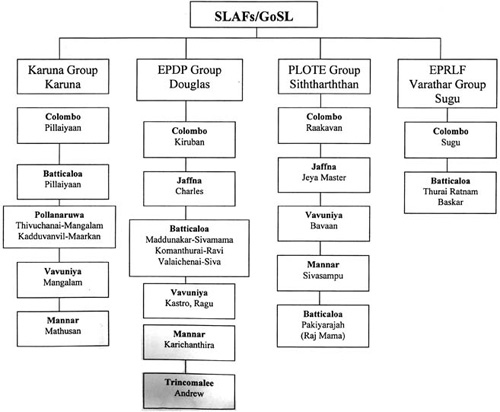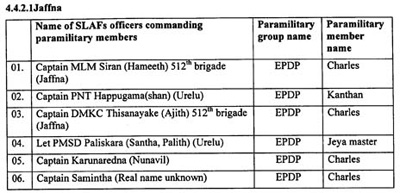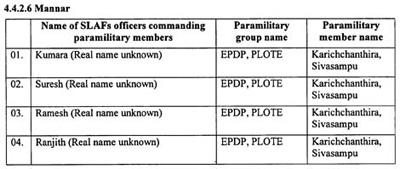The LTTE last week submitted a lengthy document to the government at the Geneva peace talks which contained evidence compiled by the organisation on paramilitaries. At the conclusion of the talks, the two sides released a joint statement that said "The Government of Sri Lanka and the LTTE are committed to taking measures to ensure that there will be no intimidation, acts of violence, abductions or killings. "The LTTE is committed to taking all necessary measures to ensure that there would be no acts of violence against the security forces and police. The Government of Sri Lanka is committed to taking all necessary measures in accordance with the Ceasefire Agreement to ensure that no armed group or person other than government security forces would carry arms or conduct armed operations." Couched in diplomatic jargon, the statement is a clear commitment by the government to disarm para-militaries in accordance with Article 1.8 of the Ceasefire. And more importantly what the SLMM needs to look after. The document is titled "Sri Lanka Armed Forces and Paramilitaries," and details LTTE allegations of armed Tamil groups working in government held areas. It said that the existence of paramilitaries was evident as early as January 2003, four months into peace talks. The Tigers allege that activity rose to alarming levels in 2005. "The existence of the paramilitaries and the GOSL’s awareness of its existence are not hotly debated anymore. What remains to be proved is that the SL armed forces is a partner in crime with these paramilitaries," the Tiger document handed over to the government delegation said. 
Overall Command Structure of Paramilitaries Claim dismissed However, the armed forces have rejected the claim. When members of the Tamil Rehabilitation Organisation went missing in Welikanda the army said that it launched its own investigation to ascertain whether paramilitary groups operated in the areas. The Military Spokesperson’s office said that it had not recovered any evidence to suggest there were paramilitaries in the area. The MOD said that it had searched some of the villages that have been mentioned as areas where the paramilitaries frequent and found no evidence. "In the north-east, LTTE having emerged as the leader of the armed struggle has set up the de facto state at the time of the signing of the CFA in February 2002. Those forces that were fighting the LTTE have always courted the other armed groups as one of their arsenal in their fight against LTTE. Both the Indian government during the presence of Indian military in the north east and later the GOSL have supported and raised the other groups in the north east for the sole reason of having a force within the Tamil community to fight LTTE," the Tigers said. 
Commenting on arguments that paramilitaries, specifically the Karuna faction came into existence after the CFA and would not fall within its purview, the LTTE said that according to the CFA, the armed forces should not allow armed paramilitaries to operate in areas under their control. The LTTE quotes press reports in The Sunday Leader (March 20, 2005) where details of the presence of Karuna loyalists at Thiruchchenai were detailed. It also quotes The Sunday Times Defence Correspondent, Iqbal Athas (December 25, 2005) which highlighted a letter written by outgoing SLMM Head Hagrup Haukland to the Government Peace Secretariat, that confirmed the presence of Karuna loyalists at Thiruchchenai. The letter said that SLMM monitors had visited Thiruchchenai and armed persons there had admitted that there were loyalists of Karuna on March 30, 2005. The LTTE report also reproduced photographs released by the Karuna faction to websites where members of the group were seen in conversation with the former SLMM station head in Batticaloa, Steen Joregensen. All this however has been public knowledge well before the LTTE handed over its dossier to the government delegation. The LTTE lists its own set of evidence, from incidents, phone numbers, to charts, personnel details and other details including bank accounts held by the Karuna group. "On the strip of road that leads from the SLAF controlled area to LTTE managed area of Vakarai, there are two checkpoints. One is exactly at the exit point just before the no-man’s land and the other few hundred metres into the SLAFs area. Paramilitaries are stationed at the inner checkpoint into the SLAF’s area. 
"There have been several attacks on LTTE members between these two checkpoints. When LTTE members enter the SLAF’s area the SLAF personnel at the entry point will inform the paramilitaries at the inner checkpoint who will come forward and attack unarmed LTTE members between the two checkpoints. "LTTE members have seen paramilitaries in SLAF uniform checking the IDs. These paramilitaries in SLAF uniform have even threatened the LTTE members for still being in the movement," one such incident related in the LTTE document said. The document also gave two bank accounts that it said were used by the Karuna group to deposit extorted money. 
The LTTE also blamed the EPDP saying it was responsible for violence in Jaffna. "During the 6-8 weeks of terror in Jaffna in December 2005-January 2006 period civilians in Jaffna have seen men in civilian clothes coming out of the Nelliady EPDP camp to join SLAF’s patrol moving from the Nelliady SLAF camp. This corroborates with the statements of many families of victims who reported this to NESOHR. These families told NESOHR that the perpetrators were paramilitaries and the SLAF’s working in collusion." The LTTE has listed the paramilitaries working with armed forces as the Karuna group, EPDP, PLOTE and EPRLF Varathan group. It has listed names of cadres and who they report to be within the security forces. 
The Tigers have also listed another group that they say is the Muslim Jihad group, active in Trincomalee. The weapons for this organisation is brought from Colombo in vehicles belonging to cabinet ministers, "it is alleged. "Training and weapons for the Jihad group are provided by the Sri Lankan military intelligence wing personnel, members of the Jihad group are mostly those who left the Sri Lanka military intelligence wing or those who ran away from the Sri Lanka military intelligence wing. 
Details In their report, the LTTE also provides maps of para-military camps and their close proximity to the armed forces camps. 
Produced elsewhere on this page are also the charts in the LTTE report with details of the handlers of the paramilitary cadres. 
The LTTE expects the government to disarm the para-military groups identified before the next round of talks in April, while the security forces denying the charges in the report is a clear indication nothing will change on the ground, be the charges true or false. Contact Numbers of Karuna Group 
|